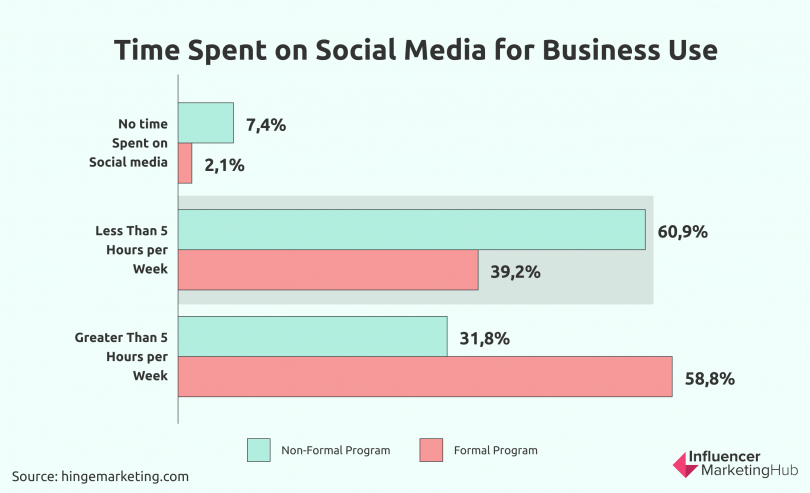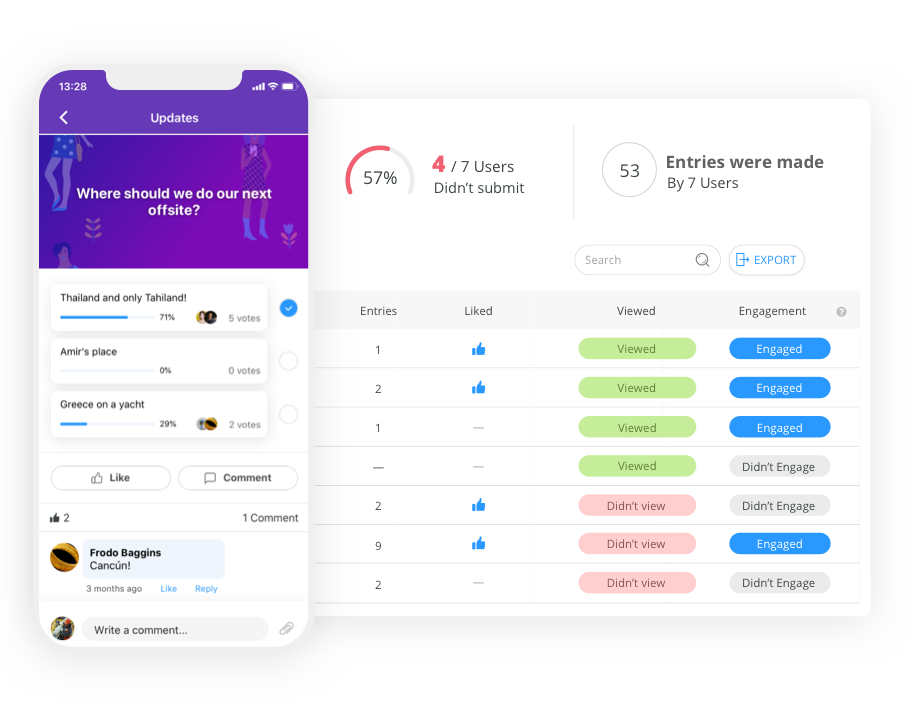Today, many companies use social media to promote their product and services. This means you can turn your employees into advocates for your company. Let’s break down what employee advocacy is and what tools you can use to make your very own program.
If you’re reading this, there’s a chance that you want your employees to love their current job. I know I do!
You want them to love it so much that they’re telling the world about it. You could say that you want them to promote your company.
In other words, you want your employees to become employee advocates.
This is actually a popular term that has been floating around for a few years now. And funnily enough, many companies actually have a lot more marketing, sales and recruiting assets than they realize.
So training your staff to become employee advocates is super easy – especially if they have a cell phone.
What Exactly Is Employee Advocacy?
When you break it down into its basics, employee advocacy is when companies empower staff members to promote its brand.
A typical employee advocate does the following:
- Uses online methods (and offline ones) to raise awareness of their company’s brand and generates positive reception.
- Recommends the company’s services or products to family, friends and members of the public.
- Always has the company’s best interests in mind.
- Has expert knowledge of the brand and is potentially a spokesperson for the company.
But the truth is that there isn’t one definitive way to promote a company’s brand. There are multiple ways.
Different Types Of Employee Advocacy
Your company may have already been implementing employee advocacy tactics without even knowing it. Here are the most common types of employee advocacy:
1. Employee Advocacy On Social Media
It’s no surprise that social media is one of the leading ways employees can become advocates of their company’s products or services. In this day and age, companies from most industries, from healthcare to retail, need to use social media to stay ahead of the competition.
Seeing that customers spend so much time on social media platforms like Facebook, Instagram and Twitter (about an hour a day on average), showing up on their social feeds is a no-brainer.

There is something to say for individuals who vouch for their company online. Having an employee sharing photos from work and articles from the company’s blog on social media is bound to improve reach.
But social media certainly isn’t the only valid type of employee advocacy.
2. Recognition Creates Employee Advocates
Employees always benefit from being recognized for their efforts – and it can only positively impact companies in the long run. In fact, studies show that 53% of employees claim they’d stay longer in a job if they felt appreciated more by their bosses.
There are numerous ways that companies can show employees recognition for their effort and achievements:
- Give high-performing employees the spotlight in team meetings
- Start an “employee of the month” program
- Create a top employees list and highlight their achievements in a monthly newsletter.
If employees feel acknowledged for their accomplishments at work, then they are more likely to want to promote the company to the public.
3. Advocate Through Swag
While it’s not a new tactic by any means, giving employees free t-shirts, bottles and other merchandise with the company logo on it is a useful way to get the brand name out there. This kind of employee advocacy does cost money, but it requires minimal effort on behalf of the employees.
The Benefits Of An Employee Advocacy Program
Companies might be skeptical whether or not it’s actually worth investing in employee advocacy. The truth though is that the rising competition in the hiring market only emphasizes the importance of this kind of program.
Similar to but not exactly the same as social media marketing, employee advocacy is still a new business strategy, meaning that the companies that implement their own programs early will be the ones who benefit the most from it.
Here are some of the most common benefits of creating employee advocacy for your company.
A recent study revealed that there are three standout benefits to employee advocacy. These are:
- Growth and sales – an increase in brand awareness and positive impressions helps improve metrics like growth, reach and sales
- Brand reputation – the company’s brand and issues management benefit considerably from employee advocacy
- Company culture – employee advocacy has a significant impact on various company aspects like recruitment, engagement and retention.
And the numbers don’t lie when it comes to increased online reach. According to the Edelman Trust Barometer, more people actually trust employees (54%) than the CEO of the same company (47%).
Now that you know the different kinds of employee advocacy and its many benefits, let’s take a look at how you can build your very own program for your company.
Use The Latest Technology To Implement Employee Advocacy
Using the latest app technology can be a vital tool when building an employee advocacy program.
Connecteam is an ideal platform that makes it easy to collect content for your employees to share on social media.
Whether you need to remind individual employees, update the entire company or evaluate your advocacy program, Connecteam ticks all of the boxes.
Through the following steps, we will break down exactly how you can build your very own employee advocacy program and how to use Connecteam to save money and time implementing it.
8 Steps To Building An Employee Advocacy Program
While companies may be eager to hit the ground running with employee advocacy, it isn’t something that companies can just wing. A lot of planning is required when it comes to building an employee advocacy program that is actually effective. Try taking the following steps to strategize the process.
Create A Positive Company Culture
You might be surprised to see this first. But the truth is that it’s impossible to make employee advocacy happen if your company doesn’t have a culture worth advocating.
An employee advocate is essentially an ambassador of the company brand. This means that salary isn’t the only thing employees should care about when it comes to their job.
In theory, a positive company culture should do two things: create social impact and improve employee experience.
Social impact can be achieved in a number of ways, such as providing a service to the public, giving back to society through charity work and proving to customers that your company is a leader in its industry.
Through promo videos, personal messages and other social media posts, employees can share their experiences with the public. This is a great way to convey a positive company culture. It can also attract new customers and employees.
Connecteam has a variety of useful features that can help improve company culture and incentivize employee advocacy. These include:
- Recognize employees by initiating 1:1 and group chats.
- Send recurring and scheduled updates to share company milestones, praise high performers and welcome new hires.
- Fill in surveys, answer live polls and supply feedback suggestion boxes to help managers make better decisions.
- Invite employees to company events and include details like location, date, time, etc.
- Supply key information such as company core values, policies and handbooks.

Set Your Goals and KPIs
While employee advocacy programs can be fun and create a positive company culture, this is just the start of the process. As a company, what do you want to achieve? It’s important to set clear goals that the employee advocacy organizers can aspire toward.
Here are some typical employee advocacy goals:
- Boost traffic on social media
- Improve online reach
- Raise number of social shares for blog posts
- Reduce marketing expenses
Connecteam can help companies build a clear KPI system to identify what they need to do to create successful employee advocacy.
- Use features like internal communication to brainstorm ideas for goals.
- Share KPI goals with employee advocates, breaking down their goals clearly.
- Send recurring and scheduled company updates informing employees when goals and KPIs have been reached.
Once you have built clear goals to help inform your strategy, you need to get your employees on board.
Explain The Value Of Employee Advocacy To Your Staff
Employees might initially be cynical about why their company is starting an employee advocacy program. They may ask why they should share company content on social media. But the earlier you explain the benefits to them, the quicker you’ll get them on board.
Promoting the company for the sake of helping it isn’t enough. Employees need to know how it benefits them and this way, they’ll be more passionate about taking part. Here are some of those benefits:
- Incentives: for top performing and the most hard-working employee advocates, it’s worth rewarding their efforts with rewards. Managers can use Connecteam’s “employee tokens” feature to give employees digital gift cards and bonuses.
- Career development: when employees share company-driven content on social media, they are likely to be perceived by readers as leaders in their field. This is a huge plus for career growth. According to a study, about 86% of employee advocates believe it had a positive impact on their careers. For example, many employees from Connecteam regularly share content from the company’s blog, which has ultimately helped build the brand and credibility even further.
- “Gamifying” the process: Attempt to make employee advocacy programs more fun by “gamifying” them. For example, you can build leaderboards showing which advocates are receiving the most engagement and impressions.
Train Your Employee Advocates
It’s not enough to simply tell employees what to post and reshare on social media. This will ultimately lead to mistakes. Employees need to learn how to use the product you are promoting and how to actually advocate.
- Provide employees with training manuals and videos that they can download at the click of a button on their phone.
- Use checklists to tick off training steps employees have completed as they go along. The more prepared employee advocates are, the better job they will do.
Create An Effective Employee Advocacy Program With Connecteam
Select An Advocacy Leader
If all communications for your advocacy program are coming directly from HR, then this might alienate readers. Hearing all of this useful information from an employee makes it feel more personal and genuine. Companies should choose a specific employee (or employees) as the advocacy leader. A representative also creates the impression that the company is treating this initiative seriously. Some duties of an advocacy rep include:
- Choose which content to share
- Motivate other employees to share
- Available to answer questions
- Evaluate the advocacy program
Staff members can use Connecteam to help the advocacy leader improve the program. Use internal communication to ask questions, and submit ideas by using the suggestion box feature. Assign both ongoing and recurring tasks for advocacy leaders to complete.
Create Social Media Guidelines For Employees
It’s also important to build social media guidelines for your employee advocates. Making sure that they know how to respond to comments, the kind of language they should use and how often they should share is crucial.
Managers can cover all bases by producing social media style and policy guides that are easy to follow. These guides can also show employees how to use specific social media platforms like Linkedin, Facebook and Instagram. They can also prevent employees from facing security and legal problems.
Employees can also send suggestions and feedback on what should and should not be included in the guidelines. Once created, managers can share these guides with their employees via the Connecteam app.

Start The Program
At this stage, the program should be ready to implement and put into practice. The advocacy leader can start to curate content for your employees to post.
Whether you work in staffing or hospitality, start off with your strongest, best performing content to give your employee advocacy program the best chance of early success.
It’s worth noting that the program isn’t guaranteed to perform well initially. Don’t be disheartened if this happens – you have time to improve it.
Keep The Program Alive
The likelihood is that your employee advocacy program will dip in performance. This might be the result of employees sharing less content as time goes on.
If this happens, advocacy leaders can use Connecteam to keep other employees in the loop. They can send reminders and notifications, as well as personal internal messages in the chat feature. Leaders can also send scheduled and recurring company updates, alerting employees of the latest content they can share.
The Bottom Line On Employee Advocacy
As previously mentioned, employee advocacy is a business strategy that is becoming increasingly popular among companies from a variety of industries. And as the aforementioned studies suggest, there are significant benefits that come with it such as improved company culture, reach, sales and brand reputation.
Practically any company that wants to build a brand should consider creating their own employee advocacy program. This could benefit companies that work in retail, tech, healthcare, real estate, and so many more.
We advise following the steps provided in this blog to get your advocacy program off and running. As long as you set goals, create advocate leaders, have all your guidelines in place and maintain the program, you’ll already be on the road to success.
And remember, using software like Connecteam is an affordable, efficient solution to helping you build your very own employee advocacy program.




